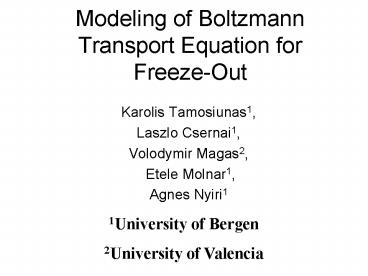Modeling of Boltzmann Transport Equation for FreezeOut PowerPoint PPT Presentation
1 / 14
Title: Modeling of Boltzmann Transport Equation for FreezeOut
1
Modeling of Boltzmann Transport Equation for
Freeze-Out
- Karolis Tamosiunas1,
- Laszlo Csernai1,
- Volodymir Magas2,
- Etele Molnar1,
- Agnes Nyiri1
1University of Bergen 2University of Valencia
2
Outline
- Gradual Freeze-Out (FO)
- Boltzmann Transport Equation (BTE) for the
Continuous FO - Modified Boltzmann Transport Equation (MBTE) and
Its Solvability - Covariant Escape Probability
- Results and Conclusions
3
The system gradual Freeze Out
IntAll particles interact in the thermal
equilibrium
free Fully Frozen out matter. Particles move
freely towards detectors.
Fig.1 Schematic view of the FO layer, described
by two 3-dim hypersurfaces in space-time
4
Boltzmann Transport Equation
- Assumptions of the BTE
- Only binary collisions.
- Molecular chaos number of collisions at x is
proportional to f(x,p1) x f(x,p2). - f(x,p) is a smoothly varying function compared to
the mean free path.
Where
5
Loss and Gain terms and FO probability
No Loss component in f f
FO of the particles from interacting component
Redistributing particles in momentum space
Collisions can be following
6
Can BTE handle FO process in the layer?
Density gradient of interacting particles is high
in the normal direction, thus
1.Molecular chaos assumption is not valid and
the number of collisions is not proportional to
It must be delocalized! i.e. proportional to
2. M.f.p. is infinite on the S1 hypersurface
all particles are frozen.
Two assumptions in BTE must be improved!
Fig.2. FO layer in xy plane. L is length of the
layer, is the direction of density
gradient.
7
Modified Boltzmann Transport Equation
where
is the collision time
How to solve MBTE?
8
Space-Time change in FO
We use Lorentz-Boltzmann linear approximation
is locally thermalized distribution
where
Describes the gradual decrease of interacting
density
Asymmetry of the momentum distribution due to
larger momentum flux from the pre-FO direction.
Particles with momentum propagates from
to , so that
, then
9
Freeze-Out Distribution
Locally equilibrated, interacting dist.
particle emitted from the collision
ST configuration of the FO layer
Performing the integral over p3 leads to an
averaging over transition rate. And assuming
small angle scatterings, that the transition
rate , then
, where
10
Covariant Escape Probability
a is influencing the FO profile
ensures, that FO particles would
not come back to the int domain.
alt1 no complete physics FO a1 complete FO agt1
power like complete FO
For simplicity one can use
is Lorentz invariant and works for
space-like and for time-like hypersurface!
11
Escape Probability in Momentum Space
Escape probability factors for different points
on FO hypersurface in the rest frame of the gas.
Momentum values are in units of mc
12
FO temperature for space-like normal
Temperature evolution of the freezing out matter
in the finite layer, for space-like direction. v0
is velocity of the particle in the FO front.
13
FO temperature for time-like normal
Temperature evolution of the freezing out matter
in the finite layer, for time-like direction. v0
is velocity of the particle in the FO front.
14
Conclusions
- Kinetic FO across the layer is fully described in
covariant form. - The applicability of BTE is analyzed and MBTE for
realistic FO is presented. - Covariant FO probability is obtained, which is
compatible with previous theoretical works.

